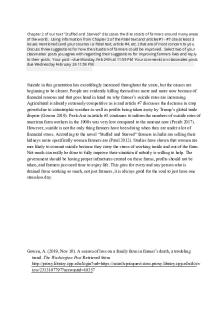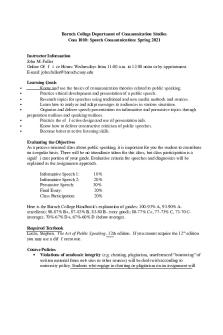LING 1010; phonemes - jon sprouse PDF

| Title | LING 1010; phonemes - jon sprouse |
|---|---|
| Course | Language and Mind |
| Institution | University of Connecticut |
| Pages | 3 |
| File Size | 83.2 KB |
| File Type | |
| Total Downloads | 62 |
| Total Views | 138 |
Summary
jon sprouse...
Description
LING 1010 Sound o Speech sounds What are the speech sounds in a given language (e.g., English)? What are the physical properties of the speech sounds in a given language (e.g., English)? Phoneme: a technical term for speech sound o The smallest segment of speech that leads to a meaningful difference between words Take a word, change one of the speech sounds in it. If the change leads to a change in the meaning of the word, then the original sound and the new sound are distinct phonemes The cognitive test for phonemes Step 1: Pick a word in the language. s a t Step 2: Change one sound in the word. s a d Different words! If the changed sound leads to a different word, then the two sounds (the original and the new one) are both distinct phonemes in the language! Here is another example of two distinct phonemes: lake rake o Different words! And here is an example of two sounds that aren’t distinct phonemes: Sat Sath o Th is a fancy way of saying “pronounce a t and blow out at the same time” so t and th are nit distinct phonemes in English The International Phonetic Alphabet (IPA) was created so that we can easily write phonemes Each phoneme that occurs in a language in the world is given a symbol
The (Roman) alphabet isn’t a very good system for naming phonemes
Letters often represent more than one speech sound
Sound is a wave that travels through air o Sound wave is a disturbance in air pressure, or how likely the air molecules are
Amplitude is a measure of the force applied to an area of air during compression. The perceptual effect of amplitude is a change in loudness. High amplitude sounds are perceived to be louder, low amplitude sounds are less loud.
Frequency is a measure of the number of compression cycles that a wave completes in a given unit of time. The perceptual effect of frequency is a change in pitch (or tone). High frequency sounds have high pitches, low frequency sounds have low pitches
Properties of your voice
There are two components of your voice: your vocal folds and your vocal tract.
Your vocal tract acts as a filter to the sound created by your vocal folds. The shape of your oral cavity and pharynx directly affects the properties of the sound.
The source of your sound comes from your vocal folds
We just need to know that your vocal tract filters the frequencies created by your vocal folds
The first important property is that your vocal folds create a large set of frequencies simultaneously (thanks to the complex physics of vibrating objects, which we won’t go into here).
The second important fact is that the shape of your vocal tract changes the amplitude of the frequencies created by your vocal folds. Some frequencies are increased, others decreased.
For the human voice, we call the highest amplitude frequencies that occur after filtering (i.e., in the EQ settings) the formants o Formants are the highest amplitude peaks in the frequency spectrum created by the human vocal tract
When you hear “ah”, you think it is a single sound. In cognitive science, we say that you perceive it as a single percept (where percept just means “thing that is perceived”).
But physically, that phoneme is really a combination of three frequencies, the three formants, put together.
The really cool thing is that you can’t hear the three frequencies, no matter what you try. You just can’t. That is because the mind is structured to perceive speech as a single percept!
Even though we can’t hear formants in speech, it is possible to hear them in music. They are called overtones in music. Overtones are always present in music - they are the reason two instruments sound different!
o Overtone signing (overtones are what musicians call formants) is a singing technique in which performers change the shape of their vocal tract to create different formants ...
Similar Free PDFs

Lexical access - jon sprouse
- 2 Pages

Mod12 tableau 36 phonemes
- 1 Pages

Apuntes JON Larrea
- 61 Pages

Table OF English Phonemes
- 4 Pages

Jon Secada- musica- vida
- 5 Pages

AG 1010
- 2 Pages

Lectures - Jon Cox
- 11 Pages

LING 115 Syllabus
- 5 Pages

Domande ling generale
- 9 Pages

Assignment 1 Ling 101
- 2 Pages

Lecture Notes LING 187
- 28 Pages

LING 222 textbook notes
- 11 Pages

COM 1010 Syllabus
- 12 Pages
Popular Institutions
- Tinajero National High School - Annex
- Politeknik Caltex Riau
- Yokohama City University
- SGT University
- University of Al-Qadisiyah
- Divine Word College of Vigan
- Techniek College Rotterdam
- Universidade de Santiago
- Universiti Teknologi MARA Cawangan Johor Kampus Pasir Gudang
- Poltekkes Kemenkes Yogyakarta
- Baguio City National High School
- Colegio san marcos
- preparatoria uno
- Centro de Bachillerato Tecnológico Industrial y de Servicios No. 107
- Dalian Maritime University
- Quang Trung Secondary School
- Colegio Tecnológico en Informática
- Corporación Regional de Educación Superior
- Grupo CEDVA
- Dar Al Uloom University
- Centro de Estudios Preuniversitarios de la Universidad Nacional de Ingeniería
- 上智大学
- Aakash International School, Nuna Majara
- San Felipe Neri Catholic School
- Kang Chiao International School - New Taipei City
- Misamis Occidental National High School
- Institución Educativa Escuela Normal Juan Ladrilleros
- Kolehiyo ng Pantukan
- Batanes State College
- Instituto Continental
- Sekolah Menengah Kejuruan Kesehatan Kaltara (Tarakan)
- Colegio de La Inmaculada Concepcion - Cebu


